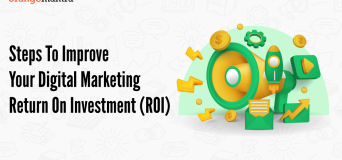You can not delegate digital transformation for your company… you and your executives have to own it! You need to embrace and adopt new ways of working with the latest and emerging technologies.
We are in the phase of irreversible disruption. Enterprises are rapidly undergoing an unprecedented change by adopting the virtues of digital transformation in business.
Especially during this phase of new normal, where nothing appears constant, companies are embracing the prowess of digitally transforming operations and accelerating growth.
Catching up with the recent and futuristic trends in business concerning technology majorly relies on the company’s CEOs’ shoulders. To be very precise, the CEO is the captain of the ship sailing the company’s growth from the traditional sphere to the tech-oriented shorelines.
That’s what CEOs of numerous enterprises commit towards their organizations to understand the call of the hour. And ready to invent their business model in new and digitally trans-formative ways.
CEO Drives the Digital Evolution in a Company
It is imperative to have an active & fluent technology CEO of the company. The leading figure of the enterprise must show a commitment towards the digital transformation of business and stay abreast of the trends. That’s because digitally enriching the enterprise is not an end, it’s a continuous process to embrace growth and development.
The CEO is the only person in an enterprise who can start the sustenance change by modifying the operations and finding new ways to work together.
Thus, it is the CEOs act of guardianship that the whole company embraces the change in operations and reimagine the growth factor.
To get you familiar with the real-life examples of such CEOs of companies, we have gathered three-point key areas that the leading figures have focused on.
Also, we like you to see the change in the business value of being digitally transformative with some operational changes.
-
Reimagine Values with Digital Agility
Becoming digitally transformative in business is not enough, you need to understand its true impact and value given to the enterprise.
That’s the true characteristic of a successful CEO of a digital company. He steps back into the process of looking at the current flow of working scenarios of the business and looking for new ways to modify and enhance the same. For a CEO, it’s not just about the change, but to foresee the real value proposition in embracing the digital way out.
A lot of time, result-oriented leaders look at their competitors, drive new trends, and technologies to implement in their business. It helps them to look again at their enterprise assets and operations with fresh eyes and move towards a radical change.
Consider the case of a leading footwear retail brand, which adopted the sales force automation application to empower the sales team.
Previously, the brand was facing several issues related to sales, with difficulty in tracking prospects and the duplication of data being the major ones. The Sales Force Automation Application facilitates the automation of the enterprise’s sales force and streamlines sales for the team and the management. The solution enables the team to complete their job within a minimal period while eliminating the need for the sales representatives to slog for hours.
The above example clearly states the CEOs driving value to the sales factor by embracing digitally powered solutions. It showcases the clarity of the business and its ongoing issues. Taking it as the critical element of the organization, steps are taken to prioritize operations digitally and bring enough value to the stakeholders and the company.
-
Attract Top Talents to Your Organization
Hiring tech-fluent talent is one of the fastest ways to accelerate the digital growth of a business. The most successful CEOs embrace this idea of finding the top talents having efficiency in emerging technologies to work for their company.
Thinking along these lines, we see CEOs collaborating with the internal recruitment departments and stakeholders to create seamless career pathways for exceptional talents. Not just that only, CEOs embrace the newer found ways to offer a disruptive corporate culture to hire new talent and catch their attention briefly.
The rise of hybrid work
“A lot of people have learned that they can work at home, or that there are other methods of conducting their business than they might have thought from what they were doing a couple of years ago. When change happens in the world, you adjust to it,” said Warren Buffett, chairman, and CEO of Berkshire Hathaway.
And he’s just one among the growing number of corporate leaders planning ambitiously to adopt hybrid work. Companies are redesigning their workplace to accommodate the hybrid model.
For instance, Salesforce redesigned spaces so that employees get a desk and two side-by-side monitors. It aims to help employees collaborate seamlessly with both in-office and remote coworkers. With smart office solutions, companies can efficiently create such designs.
-
Thrive with a Tech- and Data-Driven Model
Digital CEOs recognize the importance of business being tech and data-oriented to see internal insights, seek growth opportunities, and analyze patterns.
The most successful CEOs prioritize data and tech in two different ways. First, they ascertain the impact of technology and data-driven approach in business to find issues, opportunities, analyze competitors, and find new solutions. Secondly, CEOs ensure the organizational changes with respect to tech and data approach embedded into the system to derive much-needed value ahead.
The best example of the mentioned approach is our efforts of creating an application for IKEA (a leading furnishing brand). The application we created for the brand empowers businesses with data access anywhere & anytime.
Created the custom Point Application for IKEA which can locate and integrating the entire system to access data anywhere & anytime. It enables the users to access and view data on their devices, even from a remote location. In addition to being a point application that facilitates sales, it integrates seamlessly with other systems such as Customer Relationship Management, Inventory Management System, and analytics modules to present a holistic view of the business.
Conclusion
The digital transformation of an enterprise is not a destination. It’s a continuous evolution of the business to foresee and experience growth and success. It is only possible with the intense drive of the CEO being at the forefront to see the digital prospects, technology, and trends to drive ahead. They are the guardians of the company’s transformation and best embrace the much-needed change of their organization.
FAQ
Q. What is cloud ERP?
Cloud-based ERP is a type of enterprise resource planning (ERP) software that runs on a cloud computing platform, rather than on a business’s premises. Cloud or online ERP solutions offer great benefits in terms of cost and efficiency.
Q. How much does it cost to build a business automation solution?
The costs of developing automation software depend on several factors. The choice of technology, development time, customized features, etc. play an important role in calculating the costs. OrangeMantra develops efficient automation solutions at a competitive price.
Q. How do you modernize legacy applications?
Modernizing an enterprise’s legacy applications involve an array of steps. These include breaking down the monolithic architecture, creating a context to reduce costs, ensuring the security of applications, and integrating the processes with DevOps.






















